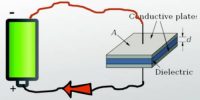When a charge q is given to an isolated conductor, its potential will change. The change in potential depends on the size and shape of the conductor. The potential of a conductor changes by V, due to the charge q given to the conductor.
q α V or q = CV
i.e. C = q/V
Here C is called as the capacitance of conductor.
The capacitance of a conductor is defined as the ratio of the charge given to the conductor to the potential developed in the conductor.
The unit of capacitance is farad. A conductor has a capacitance of one farad, if a charge of 1 coulomb given to it, rises its potential by 1 volt.
The practical units of capacitance are μF and pF.













